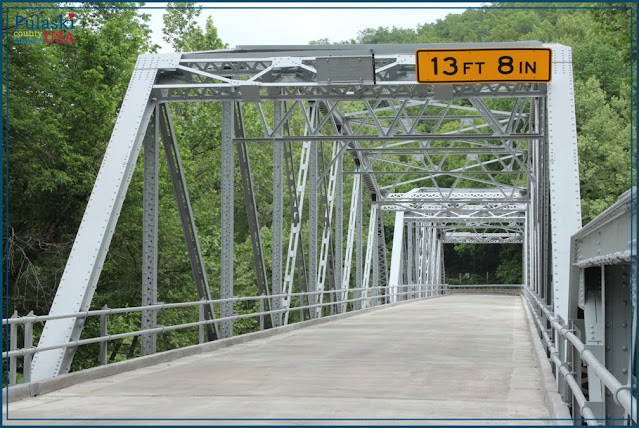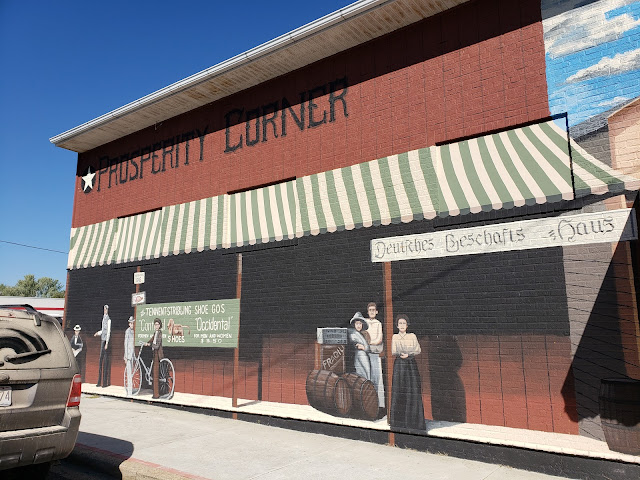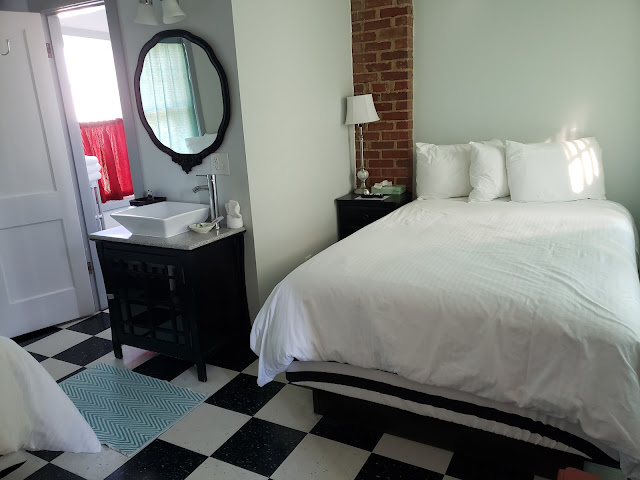After a terrific overnight stay in Cuba, Missouri, we continued southwest on Route 66 (MO Highway ZZ). About four miles south of Cuba, in Fanning, Missouri, we passed the Fanning US 66 Outpost at 5957 Highway ZZ, where we saw the World’s Second Largest Rocking Chair.
 |
| World's Second Largest Rocking Chair in Fanning, Missouri (from Afar.com) |
It was built in 2008 from steel pipes.
Route 66 soon runs along the southeast side of I-44 for a few miles. In St. James, Missouri, turn right (north) on Jefferson Street, cross I-44, then turn left (west) to continue on Route 66 on the northwest side of I-44.
About two miles after the turn, we saw a giant neon faucet at Murdon Concrete Product, 14241 Old Highway 66.
 |
| Neon faucet in St. James, Missouri |
Route 66 continues on the north side of I-44 until about two miles outside of Rolla, Missouri, where it forks right onto MO 39. When MO 39 ends, turn right (southwest) onto MO 2000. In just a few hundred feet, Route 66 turns left onto US 63 south. In Rolla, Route 66 turns right (west) onto Kings Highway. In about half a mile, Kings Highway and Route 66 turn right onto MO 72. In a few hundred feet, there’s a traffic circle. Go three quarters of the way around the circle (enter at 6 o’clock, exit at 9 o’clock) onto Martin Springs Drive. (We were really glad it was morning and we were caffeinated when we drove through Rolla!)
About two miles past the circle, in Martin Springs, Missouri, Route 66 still has its original 1931 paving. Here the road has half curbs.
 |
| Half curbs along Route 66 in Martin Springs, Missouri |
The half curbs were designed to guide drifting cars back on the road, but they actually increased rollovers. To make matters worse, Route 66 curves a bit sharply here as it approaches Little Beaver Creek, earning the nickname Deadman’s Curve.
Martin Springs Drive becomes Eisenhower Street in Doolittle, then MO 7300. When MO 7300 crosses I-44, we got on I-44 southwest for about 8 miles. We exited I-44 at MO Highway J, turning left then right to get back on MO Highway Z, which is the 1943-1957 “alignment” of Route 66. It soon expands into a four-lane divided highway. This was built during World War II to carry military vehicles to Fort Leonard Wood.
In about a mile, we turned right onto Trout Road, which parallels MO Highway Z. This was part of the 1926-1943 alignment of Route 66 through the tiny village of Hooker, and once again we got a feel for what it was like to drive cross country on Route 66 almost a hundred years ago.
We turned back onto the 1943-1956 alignment (MO Highway Z) and soon the highway passed through a cut in the hills
 |
| Hooker Cut, Missouri (from TheRoute-66.com) |
If you’ve been on interstate highways through any hilly region of the United States, this cut may not look particularly impressive, but Hooker Cut was the deepest road cut in the United States for many years and an impressive engineering feat at the time.
After Hooker Cut, we turned left (south) on Teardrop Road, which is more of the 1926-1943 alignment. In about a quarter mile, we reached the tiny community of Devils Elbow, named not for the curve in Route 66 but for the curve in Big Piney River, where lumber floated downstream would get caught.
We passed the Elbow Inn, built in the early 1930s, damaged badly by floods in 2017, and now closed. Just past the Elbow Inn, a 1923 bridge still crosses Big Piney River.
 |
| Devils Elbow Bridge, Missouri (from PulaskiCountyUSA.wordpress.com) |
The bridge is so beautifully restored that I thought it was a replacement!
About a mile past Devil’s Elbow, Teardrop Road—the 1926-1943 alignment—rejoins the newer Route 66 alignment (MO Highway Z). We followed this about 3 miles into St. Robert, Missouri, passing the huge neon sign of the Uranus Fudge Factory in Uranus, Missouri, on the way.
 |
| Uranus Fudge Factory in Uranus, Missouri (from Route66News.com) |
In St. Robert, Route 66’s east and westbound lanes split, and between them is a Route 66 relic: George Reed Roadside Park.
 |
| George Reed Roadside Park in St. Robert, Missouri (from MapQuest) |
The park was built in 1955 as a roadside park for
Route 66 travelers. It’s the only such park still in Missouri.
Route 66 soon crosses I-44 and the countryside becomes hilly—you’re in the Ozarks here. About 2 miles past George Reed Roadside Park, near Waynesville, Missouri, is Frog Rock, up on a hill on the right (north) side of the road.
 |
| Frog Rock in Waynesville, Missouri (from FourSquare.com) |
Frog Rock is above a stretch of Route 66 that cuts through hills, bends around a curve, and has no shoulders, so I don’t recommend trying to stop and photograph it.
Waynesville has a good collection of historic buildings. The Old Stagecoach Stop, built in 1854 as a hotel, is now a museum open Saturdays in summer.
 |
| The Old Stagecoach Stop in Waynesville, Missouri (from OldStagecoachStop.com) |
Past Waynesville, Route 66 (now Business I-44 and MO 17) slants back toward I-44, then runs along the north side of I-44 for about a mile. In Buckhorn, Missouri, MO 17 and Route 66 cross I-44, then turns southwest, away from I-44. This is a beautiful stretch of Route 66 through the Ozarks.
There are two “alignments” of Route 66 here, near Laquey (pronounced Lakeway). The 1930-1952 alignment of Route 66 is MO 17 for about 2 miles past Buckhorn, then forking right onto MO Highway AB.
We took the 1926-30 alignment. When Route 66 was first so designated in 1926, it was a patchwork of existing roads, and this 1926-30 segment is a good example of that. About a mile past Buckhorn, we turned right (west) on MO Highway P. We followed Highway P for about another mile, then turned left (south) on MO Highway AA. We followed Highway AA for about a mile and a half, then turned right (west) to rejoin the 1930-1952 alignment on MO Highway AB.
Route 66 (MO Highway AB) heads back to I-44. Just before the interchange, in Gascozark, Missouri, is the ruins of the Gascozark Cafe.
 |
| Gascozark Cafe in Gascozark, Missouri |
The Gascozark Café was built in 1931, with the curved top added in 1939. The multicolored “giraffe stone” is typical of buildings in the Ozarks. Over the years it’s had a gas station and been a bus stop.
We’d already seen a lot of abandoned Route 66 structures, but for some reason we found the Gascozark Café especially haunting, maybe because of its distinctive architecture, maybe because the sign is still on the building. We hope someone can find a way to restore this Route 66 treasure.
Past Gascozark, Route 66 follows along the south side of I-44, but its 1923 Gasconade River Bridge was closed during our trip, so at Gascozark we took I-44 to the next exit (MO Highway T). We then continued on Route 66 on the south side of I-44. In about 11 miles, Route 66 turns right (north) on MO Highway F, crosses I-44, then continues on the north side of I-44 into Lebanon, Missouri.
In Lebanon is one of Route 66’s iconic neon signs at the 1946 Munger Moss Motel.
 |
| Neon sign at Munger Moss Motel in Lebanon, Missouri (from MungerMoss.com) |
Route 66 continues through Lebanon in Business I-44, then edges the north side of I-44 until Phillipsburg, Missouri, where it crosses I-44 and continues on MO Highway CC on the south side of I-44 to Marshfield, Missouri. In Marshfield, Route 66 becomes MO Highway OO. Just east of Springfield, Missouri, Route 66 becomes MO 744. Our next stop was Springfield, Missouri, one of the many great towns along Route 66.




































